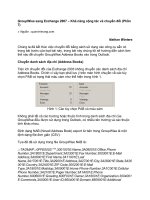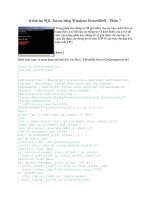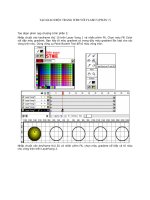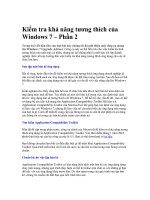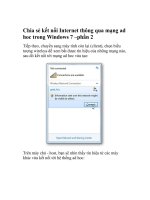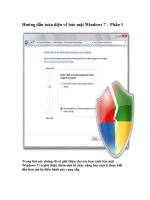Drupal 7 First Look phần 7 docx
Bạn đang xem bản rút gọn của tài liệu. Xem và tải ngay bản đầy đủ của tài liệu tại đây (354.63 KB, 28 trang )
Chapter 5
[ 153 ]
After the comment section, the template opens the div containing the node and
prints any classes and attributes that have been dened for the node:
<div id="node-<?php print $node->nid; ?>"
class="<?php print $classes; ?> clearfix"<?php print $attributes; ?>>
This procedure is similar to the Drupal 6 procedure except that the the $classes
variable is used rather than having the template attempt to determine the
appropriate classes to display. Drupal 6 also used a clear-block class rather than the
new clearx class.
Next, the author's picture is displayed if it is set and any contextual links that were
passed in are rendered:
<?php print $user_picture; ?>
<?php if (!$page && !empty($contextual_links)): ?>
<?php print render($contextual_links); ?>
<?php endif; ?>
Since the $user_picture variable has already been rendered in a template, it is
simply printed. The contextual links are new to Drupal 7. They are rendered after
checking to ensure that they exist and should be printed.
The template now prints the title of the page:
<?php if (!$page): ?>
<h2<?php print $title_attributes; ?>>
<a href="<?php print $node_url; ?>">
<?php print $node_title; ?>
</a>
</h2>
<?php endif; ?>
Again, this code is very similar to the Drupal 6 code. The only real addition is the
rendering of the $title_attributes variable, which allows you to add additional
classes to the node title or add any other HTML attributes you might want.
The next section of the template displays submission information if enabled, as well
as taxonomy terms. These are both wrapped within a meta div, which the default
Drupal 7 template ensures is not displayed when it is empty:
<?php if ($display_submitted || !empty($content['links']['terms'])):
?>
<div class="meta">
<?php if ($display_submitted): ?>
<span class="submitted">
<?php
Drupal 7 for Themers
[ 154 ]
print t('Submitted by !username on !datetime',
array('!username' => $name, '!datetime' => $date));
?>
</span>
<?php endif; ?>
<?php if (!empty($content['links']['terms'])): ?>
<div class="terms terms-inline">
<?php print render($content['links']['terms']); ?></div>
<?php endif; ?>
</div>
<?php endif; ?>
As mentioned earlier, the submission information is no longer passed to the node
template pre-rendered. Therefore, it is rendered directly in this template. Similarly,
the links are passed into the template through the $content array and are rendered
within the template.
With the meta information displayed, the template is now ready to display the
content, which it does using the following lines:
<div class="content"<?php print $content_attributes; ?>>
<?php
// We hide the comments and links now so that we can render them
later.
hide($content['comments']);
hide($content['links']);
print render($content);
?>
</div>
This code demonstrates the use of hiding specic sections within the $content array
before rendering the entire $content array. In this case, the comments and links are
removed and all remaining content is rendered. This allows the remaining content
to be rendered in a specic order and wrapped within different div instances. The
content that was excluded is now rendered by the template using the following code:
<?php print render($content['links']); ?>
<?php print render($content['comments']); ?>
This is similar to how the content was rendered within Drupal 6 except that
comments were rendered with the main content.
At this point, the template closes the main div for the node and ends.
Chapter 5
[ 155 ]
template.php
The template.php le is where you will override theme hooks to modify how
information is displayed on your site. The basic functionality of this le is identical to
the Drupal 6 version. However, a number of the hooks that you can implement have
changed. We will explore all of the hooks in more detail shortly.
The other key change to the
template.php le is that hook implementations must be
prexed with the name of the theme. They can no longer be prexed with the theme
engine name since this caused several problems with sub-themes including the
possibility that a hook would be called multiple times.
Other changes
There are a few other changes to the template system that are worth mentioning:
• The only other major change to the theme templates is the removal of the
box.tpl.php le. The box.tpl.php le was rarely used and the areas that
did use them now have specic theme functions that can be used to control
the display.
• The
block.tpl.php template le has been moved from the system module
to the block module for better consistency.
• As has been mentioned before, a number of special elements have been
removed and replaced with blocks to simplify Drupal and make theming
easier. The special content that has been removed includes: help, mission
statement, content, and footer message.
New JavaScript functionality
Starting in Drupal 7, additional JavaScript tools have been included to make
development easier and allow you to make your sites more dynamic. This also
makes Drupal itself more dynamic and allows Drupal core to implement modern
new functionality expected in today's websites.
Drupal 7 for Themers
[ 156 ]
jQuery tools
The following jQuery libraries are now included with Drupal by default:
• jQuery 1.3.2—the latest version of jQuery is included with Drupal core and it
is included on all pages by default so you don't need to do anything special
to use jQuery in your theme.
• jQuery UI 1.7.2—the latest version is included with Drupal in the
misc/ui
folder of the installation. Only UI core is included on all pages by default.
If you want to utilize other scripts on your page, you will need to make
appropriate calls to
drupal_add_js and drupal_add_css from your
theme or module.
• jQuery Forms 2.21—jQuery Forms allow forms to utilize AJAX to submit
the form. This functionality must be included with a call to
drupal_add_js
if you want to utilize it on a specic page.
• jQuery Once 1.2—this plug-in allows you to ensure that a behavior only
executes once. This reduces the amount of code needed to handle common
jQuery tasks.
jQuery is a really easy library to work with in JavaScript and makes even complex
tasks easy (or at least relatively easy). A full discussion of jQuery is beyond the scope
of this book. For more information about jQuery, pick up either Drupal 6 JavaScript
and jQuery or Learning jQuery, 1.3 both from Packt Publishing.
AJAX framework from CTools
In addition to the new jQuery tools in Drupal 7, the AJAX framework from the
popular CTools project maintained by merlinofchaos has been added to Drupal core.
This new framework extends and may eventually replace the AHAH framework,
which was introduced in Drupal 6.
The new AJAX framework allows you to dene a custom callback that will handle
the AJAX request and return information to the browser.
Additional information about this new framework is available at
http://drupal.
org/node/544418
.
Chapter 5
[ 157 ]
Including other JavaScript libraries
If none of these new libraries suit your needs or if it is not included by default, you
can use the drupal_add_js method to include additional JavaScript les in your
page. The signature of this method has changed from Drupal 6 to Drupal 7 and there
are some new features available. The new method signature is:
drupal_add_js($data = NULL, $options = NULL)
The parameters that were added individually after the $data option are now
included within the $options array.
You can now use
drupal_add_js to add external les to the page. This is done by
setting the type to external in the options array. For example, you can specify:
drupal_add_js(' array('type' =>
'external');
CSS changes
Several changes have been made to the classes and IDs, which are available for
styling your pages. These changes allow more granular control when styling your
pages. Let's look into each change in detail.
System classes
Drupal 7 has modied the classes that are generated when the core blocks are used in
your site. The new names are designed to make your CSS les easier to understand
and make it easier for new themers to quickly style the built in blocks.
The following list contains the old and new IDs for each block:
Block Name Drupal 6 ID Drupal 7 ID
Recent blog posts block-blog-0 block-blog-recent
Book navigation block-book-0 block-book-navigation
Recent comments block-comment-0 block-comment-recent
Active forum topics block-forum-0 block-forum-active
New forum topics block-forum-0 block-forum-new
Language Switcher block-locale-0 block-locale-language-switcher
Syndicate block-node-0 block-node-syndicate
Most recent poll block-poll-0 block-poll-recent
Author information block-prole-0 block-prole-author-information
Download f r o m W o w ! e B o o k < w w w.woweb o o k . c o m >
Drupal 7 for Themers
[ 158 ]
Block Name Drupal 6 ID Drupal 7 ID
Search form block-search-0 block-search-form
Popular content block-statistics-0 block-statistics-popular
Powered by Drupal block-system-0 block-system-powered-by
User Login block-user-0 block-user-login
Navigation block-user-1 block-user-navigation
Who's new block-user-2 block-user-new
Who's online block-user-3 block-user-online
To preserve the styling of these blocks in Drupal 7, you will need to modify your CSS
le or les to refer to these elements using their new IDs. For example, this code in
Drupal 6:
/* Add a blue border around the author information block */
#block-profile-0{
border: 2px solid blue;
}
will look like the following in Drupal 7:
/* Add a blue border around the author information block */
#block-profile-author-information{
border: 2px solid blue;
}
Classes array
As we saw earlier when we went through the node template, the classes for a
node are now built in the $classes_array variable during the preprocess routines
for a node. The classes to be applied are then attened and can be easily rendered
within the node template. If you were generating custom classes in your Drupal 6
theme, you should consider moving the generation to a preprocess routine in your
Drupal 7 theme.
Chapter 5
[ 159 ]
Hiding information
Drupal 7 has added several classes to make it easier to hide content generated by
Drupal and to make hidden content more friendly to screen readers. These include:
•
.element-hidden, which renders the content as completely invisible to all
users including screen readers. This can be used to toggle collapsible eldsets
and other content that is only displayed when the user clicks on a specic
link.
•
.element-invisible, which makes the content invisible to normal users,
but visible to screen readers. This allows you to easily provide alternate
content for images, Flash videos, and other content that might be otherwise
lost to visually impaired visitors. You should make sure to not include any
links or other navigation elements within this content to avoid causing
problems for visitors.
Theme API changes
Now that we have gone through the changes in the major Drupal templates and
covered the major changes related to JavaScript and CSS, let's look into the changes
to the actual theme API. These functions are implemented within your theme's
template.php le and give you immense control over the presentation of elements
within your site.
Signature changes
The rst thing you will notice when you try to upgrade your Drupal 6 theme to
Drupal 7 is that all functions now take a $variables array rather than a list of
parameters in the method signature. This allows for consistent pre-processing of
variables and makes coding easier. Unless noted otherwise later in this chapter, all
parameters that used to be passed to a theme function are now available within the
variables array using the original parameter name. For example, in Drupal 6, the
theme_date method was implemented as follows:
function theme_date($element) {
return theme('form_element', $element,
'<div class="container-inline">' .
$element['#children'] .
'</div>');
}
Drupal 7 for Themers
[ 160 ]
In Drupal 7, the same function is implemented as:
function theme_date($variables) {
$element = $variables['element'];
return '<div class="container-inline">' .
drupal_render_children($element).
'</div>');
}
To override a theme hook in your custom theme, you will need to replace the word
theme in the function name with the name of the theme. So for the drupal_7_rocks
theme to override the theme_date hook, it would create a function called drupal_7_
rocks_date
in the template.php le.
Alter hooks
In Drupal 6, themers were unable to use the hook_alter functions like hook_form_
alter
, hook_page_alter, hook_js_alter, and hoook_css_alter. This resulted in
many production themes needing to implement a module that only implemented
these methods for the theme. Managing the module in addition to the theme was a
hassle that caused lots of extra work for production site administrators. Thankfully,
in Drupal 7, this restriction has been lifted and themes can now implement these
functions. Care should be taken to ensure that only presentation-related changes are
made within the theme. If you need to change functionality, you should implement a
module instead.
As always, these are implemented by replacing the word hook with the internal
name of your theme. For example, to implement
hook_css_alter for the theme
drupal_7_rocks, you would use the function:
/**
* Implement hook_css_alter().
*/
function drupal_7_rocks_css_alter(&$css) {
//Remove unwanted css files and/or
//add additional theme specific css.
}
Chapter 5
[ 161 ]
New methods
Let's look at the new theme hooks that are available within Drupal 7. In this book, we
will limit our discussion to a listing of the method as well a description of what the
method does. If you need more information including information about the default
implementation, visit and enter the name of the function
you want more information on.
template_preprocess_menu_tree(&$variables)
This method allows you to add additional information about menu items to the
menu tree including adding classes to different levels within the tree. This method
is called before any rendering is done.
template_preprocess_username(&$variables)
Allows you to alter information related to the name of the active user as well as
links to the user's prole and home page. This method is called before any
rendering is done.
template_process_username(&$variables)
Provides a second level of processing to the username, which is completed after
all modules have had a chance to preprocess the data.
theme_admin_block($variables)
Allows you to override the display of blocks for site administrators. You can display
the title, description, and content of the block.
theme_conrm_form($variables)
Allows you to change how conrmation forms are displayed. By default, no changes
are made to the default rendering of forms. However, you can add additional text or
classes to the form.
theme_container($variables)
Displays a container for related items within a form.
Drupal 7 for Themers
[ 162 ]
theme_dashboard($variables)
Controls the appearance of the dashboard within the administrative interface. The
default implementation also uses this method to add the CSS le controlling the
overall appearance of the dashboard.
theme_dashboard_admin($variables)
Displays the area of the dashboard that allows you to customize the dashboard.
This is a full list of available blocks that can be added to the dashboard.
theme_dashboard_disabled_block($variables)
Displays a single block, which is disabled in the dashboard. Only used while the user
is customizing the dashboard.
theme_dashboard_disabled_blocks($variables)
Themes a group of disabled blocks in the dashboard. Only used while the user is
customizing the dashboard.
Chapter 5
[ 163 ]
theme_dashboard_region($variables)
Themes a region within the dashboard. By default, the dashboard has a main region
and a sidebar region.
theme_lter_guidelines($variables)
Renders the guidelines for a Text format within a content creation page. The
guidelines describe how the Text format behaves.
theme_form_element_label($variables)
Displays a label for a eld within a form. If the eld is required, a required marker
is output. The actual marker is rendered using the theme_form_required_marker
function which is coming up next.
Drupal 7 for Themers
[ 164 ]
theme_form_required_marker($variables)
Displays the indicator that a eld is required. In the previous screenshot, the
required marker is the red asterisk.
theme_forum_form($variables)
Another convenience function similar to the confirm_form hook. This allows you to
override the display of just the form to create forums.
theme_html_tag($variables)
Controls the display of an HTML tag, which appears within the head section of a
document. The default implementation can render additional attributes and prexes
and sufxes to allow the rendering of CDATA content.
theme_image_anchor($variables)
Displays a group of radio boxes that are used to control the anchor point when an
image is processed.
theme_image_crop_summary($variables)
Displays a summary of the settings for a crop operation when image styles are
being created.
theme_image_resize_summary($variables)
Displays a summary of the settings for a resize operation when image styles are
being created.
Chapter 5
[ 165 ]
theme_image_rotate_summary($variables)
Displays a summary of the settings for a rotation operation when image styles are
being created.
theme_image_scale_summary($variables)
Displays a summary of the settings for a scale operation when image styles are
being created.
theme_image_style_effects($variables)
Displays a list of all image effects that have been added to a style and allows users
to add, remove, or reorder the effects in a style.
theme_image_style_list($variables)
Displays a list of all image styles that are available within the system, with all
operations that can be taken on each style.
theme_image_style_preview($variables)
Creates and displays a preview of the effects of applying an image style to an
example image.
theme_link($variables)
Called from the l() function. This method allows you to override the rendering
of links in the system. Before overriding this method, you should carefully
consider if there is another method of accomplishing your end goal because using
the theme_link hook can slow down the rendering of your site considerably.
Drupal 7 for Themers
[ 166 ]
theme_locale_date_format_form($variables)
Themes the form to control the date formats that are selected for a
particular language.
theme_locale_languages_congure_
form($variables)
Renders the form, which allows you to congure the languages that are available
on the site and adds additional information for proper conguration.
theme_locale_translation_lters($variables)
Gives you control over the locale translation form generated by the locale module.
theme_menu_link(array $variables)
Generates the HTML for a specic link within a menu. This gives you a lot of control
over how the menu appears.
theme_menu_local_action($variables)
Generates the HTML for a local action within a node.
theme_rdf_metadata($variables)
This function generates RDFa content as a series of empty spans containing attributes
describing the content that is understood by RDFa parsers.
Chapter 5
[ 167 ]
theme_rdf_template_variable_wrapper($variables)
Generates a wrapper around an HTML element that contains additional RDF
information about the element. This method is only needed for template variables
that need containing attributes. If you are already outputting the proper attributes in
your templates, you can override this method to not wrap the variable by calling:
drupal_attributes($rdf_template_variable_attributes_array[$variable_
name]);
theme_shortcut_set_customize($variables)
Renders the list of shortcuts that exist within a set of shortcuts and properly
handles rearranging existing shortcuts and properly displaying shortcuts that
have not been set.
theme_system_compact_link()
Renders a link to show or hide inline help descriptions.
Drupal 7 for Themers
[ 168 ]
theme_system_date_time_settings($variables)
Generates the display for the date settings form:
theme_system_modules_eldset($variables)
Used to display the list of modules that are available on the site with information
about the modules that it requires and the modules that require it to be activated
so that administrators can enable modules.
theme_system_modules_incompatible($variables)
Properly renders a message to indicate an incompatibility.
theme_system_run_cron_image($variables)
Generates content to run cron if a user's browser does not support JavaScript.
You should not override this hook unless you have a strong understanding of
the cron system.
theme_system_settings_form($variables)
Like some of the other hooks we have seen, this is provided as a convenience if you
need to override the settings form.
theme_system_themes_page($variables)
Generates the content for the page, which allows administrators to select the theme
for the site and enable new themes.
Chapter 5
[ 169 ]
theme_text_format_wrapper($variables)
This method is in charge of properly wrapping a form element that can utilize
text formats.
theme_update_last_check($variables)
Displays information about when Drupal last checked for updates to Drupal
and any installed modules and themes. The method also adds a link to check
for updates manually.
theme_update_manager_update_form($variables)
Themes the form that allows a site administrator to select which projects should
be updated as well as which version each project should be updated to.
theme_user_admin_permissions($variables)
Controls the display of the permissions page to allow site administrators to control
what actions each user can take within the site.
theme_vertical_tabs($variables)
Renders eldsets for an element as the new vertical tabs element. We saw this
element extensively when creating content, content types, and so on.
Removed methods
Now that we have looked into the methods that Drupal 7 has added for themers,
let's take a quick look at the methods that were removed. We will also look at some
potential ways of replacing the functions that were removed:
Method Name Additional Information
theme_blocks
This was only used by the chameleon theme, which is no
longer included in core.
theme_box
This function was only used in the comment module and
search form and the functionality is now directly implemented.
theme_closure
This hook was removed since closure is now handled
with $page_bottom variable, which is rendered in
html.tpl.php.
Drupal 7 for Themers
[ 170 ]
Method Name Additional Information
theme_comment_admin_
overview
theme_comment_
controls
theme_comment_flat_
collapsed
theme_comment_flat_
expanded
theme_comment_
submitted
theme_comment_
thread_collapsed
theme_comment_
thread_expanded
theme_comment_view
These hooks were all removed after comments were simplied
in Drupal 7.
theme_help
Removed in favor of having help be a block rather than a
special piece of content.
theme_item
This hook was no longer needed due to changes to the code
that called it and was removed.
theme_menu_item
These methods are no longer needed due to the ability to add
classes to an element and preprocess variables.
theme_menu_item_link
This is not needed due to the ability to add localized options
to any link element.
theme_node_admin_
nodes
This is no longer needed due to changes in the form.
theme_node_submitted
This was removed in favor of direct theming within the
node.tpl.php template.
theme_password_
confirm
This is no longer needed due to the new password validation
functionality.
theme_system_modules
This hook was replaced with theme_system_module_
fieldset.
theme_system_themes_
form
theme_system_theme_
select_form
These hooks were replaced with theme_system_themes_
page.
theme_taxonomy_term_
page
This is no longer needed due to changes in the form.
Chapter 5
[ 171 ]
Method Name Additional Information
theme_taxonomy_term_
select
This is no longer needed because the taxonomy term is a
simple select box that can be rendered using the normal theme
system.
theme_token
This function just marked elements as hidden. There are now
better ways of handling this in Drupal 7.
theme_upload_
attachments
theme_upload_form_
current
theme_upload_form_
new
These hooks were changed due to the removal of the upload
module in favor of le elds.
theme_user_admin_
account
theme_user_admin_
perm
These hooks were not called in Drupal 6. Therefore, they were
removed in Drupal 7.
theme_xml_icon
This hook was replaced by theme_feed_icon in Drupal 6
and has been removed in Drupal 7.
Upgrading Drupal 6 themes to Drupal 7
The process of converting Drupal 6 themes to Drupal 7 involves modifying your
theme to take advantage of all of the new features and modifying the syntax of your
method calls to utilize the new method syntax. Any calls to functionality that has
been removed will also need to be revised. You can nd a complete list of changes
that need to be made at: />You can use the following basic procedure for updating your theme to Drupal 7:
1. Update your .info le to include any additional scripts and CSS les that
are needed by your site and make sure to include style.css and script.js
if you use them.
2. Modify the structure of your page.tpl.php page to remove the information
contained in html.tpl.php.
3. Modify the rendering of each region to use region.tpl.php and to load
content from the $page variable.
4. Replace removed special content types with blocks as needed.
5. Change variable names that have been modied including the main_menu
and secondary_menu.
Download f r o m W o w ! e B o o k < w w w.woweb o o k . c o m >
Drupal 7 for Themers
[ 172 ]
6. Add additional classes to HTML elements as needed to render the page.
7. Update template.php to utilize the new API method signatures.
8. Replace method calls that have been removed with new functionality.
9. Test everything and continue to tweak as needed.
Summary
In this chapter, we have gone through all of the major changes to the Drupal theme
system that were introduced in Drupal 7. We looked at changes to the template
les, changes for JavaScript, changes for CSS, API changes, and nally we worked
through a basic roadmap for upgrading an existing Drupal 6 theme to Drupal 7.
Hopefully, you now have a solid understanding of the new features available to you
in Drupal 7 and can take advantage of all of the new tools.
In the next chapter, we will be looking into the changes made to the Drupal API,
which will affect module developers.
Drupal 7 Database Changes
In the last chapter, we looked at changes to the theming system that were introduced
in Drupal 7. These changes have made the API more robust and easier to use. They
also make it easier to implement high quality themes for your site.
In this chapter, we will look at changes to the database abstraction layer of the
Drupal API. There are several signicant changes to the Drupal API that have been
made for version 7. The biggest of these is the new DBTNG layer, which provides an
abstracted layer between Drupal and the database that stores your content. We will
explore the DBTNG layer in detail during this chapter. In the next chapter, we will
explore the other major changes and new features of the API including:
• Using the Field API
• Image handling API
• Revised tokens and actions
• RDF API
• Permissions changes
• Taxonomy changes and much more
Without further ADO, let's start looking into the new DBTNG layer, which is critical
for all Drupal 7 modules.
What is DBTNG?
DBTNG is the new database abstraction layer that makes connecting to and querying
the database much easier in Drupal 7 than it was in the previous version of Drupal.
DBTNG is an acronym for Database Layer: The Next Generation.
Drupal 7 Database Changes
[ 174 ]
Background
DBTNG was built with the intention of making it easier to support additional
types of databases. Prior to Drupal 7, it was theoretically possible to create a
Drupal-compliant compatibility layer to support any database. However, this
required quite a lot of custom code and each custom module typically needed to
add customized SQL statements to support multiple databases. In practice, this
meant that Drupal only fully supported MySQL and PostgreSQL. Most contributed
modules only supported MySQL although some also supported PostgreSQL. Site
administrators who wanted to use a different database needed to do a great deal of
work to migrate modules or build their own modules with support for their database
of choice.
Some of the other key goals for DBTNG were:
• Support for multiple database servers
• Provide support for transactions
• Provide an interface to make building complex dynamic queries easier
• Ensure that security checks are enforced and cannot be overridden
• Make it easier for custom modules to intercept and enhance queries
generated in core or in other custom modules
The new DBTNG layer is based on the PHP PDO (PHP Data Objects) library.
The PDO library is designed to give developers a consistent interface to access
any database that has a PDO-compatible driver from PHP. The PDO interface is
completely object-oriented, which means that DBTNG also uses object-oriented
constructs to deliver its functionality.
Key concepts in DBTNG
There are several key concepts that you need to be aware of when working with
DBTNG. Many of these concepts are derived from PDO so if you are familiar with
that, you will have no problem transitioning to DBTNG.
Drivers
Drivers in DBTNG are in charge of taking the base statement built by the user and
transforming it into a SQL statement that is valid for the database you are working
with. Each database type must have a driver built for it to work with Drupal 7. The
default installation includes drivers for MySQL, PostgreSQL, and SQLite. Other
drivers may be available after release as custom modules or patches.
Chapter 6
[ 175 ]
Drivers are installed in the includes/database directory of your Drupal
installation. Each driver is given its own sub-folder, which should be named
based on the database name and it should typically only contain lower case letters.
Drivers typically consist of four include les that contain classes which override
core database functionality. These include:
•
database.inc—contains classes related to database connection as well as
providing the possibility to override functionality needed by DBTNG that is
not provided by the database, and to optimize DBTNG functionality, which
has a direct implementation within the database.
•
install.inc—contains a class to extend the core DatabaseTasks class with
functionality that is needed to prepare a database for use with Drupal.
•
query.inc—contains classes which override the core classes that implement
the core query classes including InsertQuery, UpdateQuery, SelectQuery,
MergeQuery, DeleteQuery, and TruncateQuery.
•
schema.inc—contains classes to dene how the driver should create tables
and columns within the database as well as return information about the
structure of the database.
A complete description of building new database drivers is beyond the scope of
this book. However, additional information is available at:
/>node/310087
.
Connections
Connections are extended from PDO connections (the PDO class). Each database
that is congured within the Drupal settings.php le is given a single Database
connection object that is active throughout the page request. In general, you should
not need to work with the connection object directly unless you are doing a very
complex database manipulation involving multiple databases.
You can retrieve the currently active connection within your module using the
following statement:
<?php
$conn = Database::getConnection();
?>
Drupal 7 Database Changes
[ 176 ]
You can modify the active connection using the following statement:
<?php
db_set_active($key);
?>
Where $key is the key of the database in the $databases array within settings.
php
. All sites will have the default key dened. And, in most cases, this is the only
database dened.
The following snippet taken directly from
settings.php shows the location of the
key name and target name within the settings.php le:
$databases = array (
'keyname' =>
array (
'targetname' =>
array (
'driver' => 'mysql',
'database' => 'databasename',
'username' => 'username',
'password' => 'password',
'host' => 'localhost',
'port' => '',
),
),
);
If you need to manually open a connection you can do so by specifying the target
and key of the connection to be opened as shown in the next code snippet:
<?php
$conn = Database::getConnection($target, $key);
?>
A new connection will only be opened the rst time that a request for it is made. This
prevents unnecessary connections from being made and not used for each page load.
You can dene connections to additional databases by adding information about
them to your
settings.php le. For example, to dene a connection to a secondary
SQLite database, you would add information about it after the default Drupal
database has been dened as shown in the following snippet:
<?php
$databases['default']['default'] = array(
'driver' => 'mysql',
Chapter 6
[ 177 ]
'database' => 'drupaldb1',
'username' => 'username',
'password' => 'secret',
'host' => 'dbserver1',
);
$databases['extra']['default'] = array(
'driver' => 'sqlite',
'file' => 'files/extradb.sqlite',
);
?>
In this case, the secondary database would be accessed using the extra key.
Statements
Statements are used to retrieve data from the database. This information can then
be displayed on the page or used within calculations. A DBTNG statement
represents a SELECT statement in SQL and is of type DatabaseStatement (unless
the DatabaseStatement class has been sub-classed within the database driver).
The DatabaseStatement is derived from the PDOStatement class within PDO.
When a statement is executed against a connection, the DBTNG layer will perform
the following operations:
1. Build a prepared statement using PDO.
2. Set up the parameters for the statement using data passed to the query.
3. Execute the prepared statement.
4. Return the result set to the user.
The key difference between Drupal DatabaseStatement and the PDOStatement
is that Drupal does not expose the prepared statement to the developer. This
ensures that the prepared statement cannot be changed incorrectly and makes
the module code signicantly easier to read. We will look into statements in much
more detail shortly.
Queries
Queries represent SQL statements that are sent to the database connections
that manipulate data including inserts, deletes, updates, and so on. A query
can either be created using a traditional SQL statement string or it can be built
using the object-oriented query builder.


